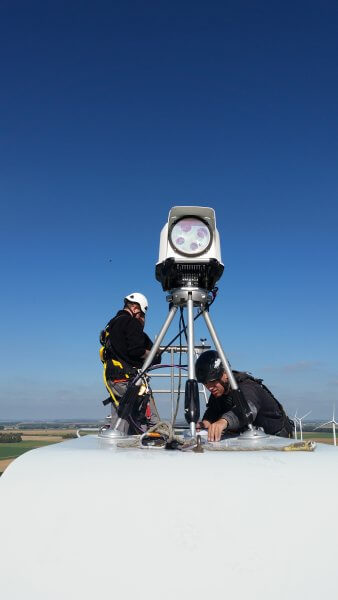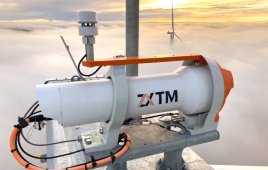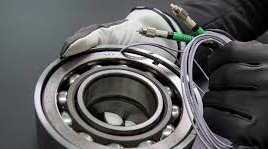By Matthieu Boquet, Head of Products & Offering, Leosphere, a Vaisala company
Harnessing the wind is not exactly a perfect science.
From taller and more efficient wind turbines to the development of wind farms in increasingly complex onshore and offshore environments, the wind energy sector is constantly evolving, and new techniques and technologies are becoming available to ensure that turbine and wind farm performance meets expectations and contractual obligations. One such technology is the use of lidar sensors in power performance testing (PPT) to easily and efficiently adhere to industry standards and best practices.
Power Performance Testing
 Wind energy industry best practices include comparing actual turbine performance on a site with the contracted performance often used as the basis for energy and revenue estimation. A key parameter of the economic value of a wind project, the power curve is determined through PPT.
Wind energy industry best practices include comparing actual turbine performance on a site with the contracted performance often used as the basis for energy and revenue estimation. A key parameter of the economic value of a wind project, the power curve is determined through PPT.
The power curve shows the relationship between turbine power and hub height wind speed, essentially capturing turbine performance. By plotting the power versus wind speed, the power curve compares on-site results to that of the warranted power curve. During the commissioning phase of a project, PPT data helps verify the configuration and installation of turbines to ensure the wind turbine is set to deliver the expected power output. Beyond turbine performance verification, PPT is also conducted for regulatory compliance and warranty verification.
To verify turbine performance, PPT often happens once they are operational on a wind farm. A detailed, IEC-compliant test and analysis can ensure that projects are performing as they should, maximizing the annual energy production (AEP) and potential revenue of a wind farm.
Given the increasing size of turbines (both on- and offshore), even if there’s a slight difference in the real-world production compared to a turbine’s expected power production, that can mean a significant — and costly — change in the project’s economy. In fact, data from the Electric Power Research Institute (EPRI) reveals that just a 1% decrease in annual production can reduce the revenue of a wind farm with 100 2-MW turbines by up to $500,000 per year. While developers and operators expect to get the energy output promised, without accurate PPT data, it’s impossible for them to determine whether each turbine is performing as it should.
Meteorological evaluation towers — commonly called met towers or met masts — and calibrated turbine-mounted cup anemometers have traditionally been the primary options for conducting the wind measurements required to verify power performance. However, turbine anemometers are highly uncertain because of their location behind the turbine rotor, and as turbine rotor sweeps grow beyond 200-m in height, met towers are not able to deliver PPT data with the vertical measurement and accuracy required. Plus, installing a met tower onshore for PPT is expensive and needs time, while using met towers for offshore wind farm environments is impractical due to the requirement of a multimillion-dollar foundation being constructed out in the ocean. Because met towers have been the only option for some time, there are very few PPT campaigns performed in the field.
With turbines continuing to grow larger, performance testing and verification is becoming increasingly important as underperformance equates to reduced power output and significant lost revenue. That’s where lidar comes in.
Lidar for Power Performance Verification
 Whether developing or operating a wind project, lidar sensors help decision-makers understand what the wind is actually doing at a given site. Ground-based vertical profiler lidars are already regularly used for PPT after the release of IEC 61400-12-1 Ed. 2 Standard. Alternatively, by accurately measuring the full wind regime and characteristics of the wind flow, including wind speed, wind direction and turbulence all the way up to 700 m in distance, the most advanced nacelle-mounted lidars allow for data that is easily attainable, accurate and in line with industry PPT best practices.
Whether developing or operating a wind project, lidar sensors help decision-makers understand what the wind is actually doing at a given site. Ground-based vertical profiler lidars are already regularly used for PPT after the release of IEC 61400-12-1 Ed. 2 Standard. Alternatively, by accurately measuring the full wind regime and characteristics of the wind flow, including wind speed, wind direction and turbulence all the way up to 700 m in distance, the most advanced nacelle-mounted lidars allow for data that is easily attainable, accurate and in line with industry PPT best practices.
Adhering to wind industry best practices and an upcoming IEC standard, advanced lidar sensors are able to mount temporarily on or fully integrate into the nacelle, enabling operators and wind turbine original equipment manufacturers (OEMs) to efficiently and accurately assess turbine performance. PPT can also be performed using a ground-based vertical profiling lidar, and the choice of which one to use is specific to each use case.
In addition, some out-of-the-box software platforms streamline the delivery of power performance data in a simplified fashion, making it accessible to wind industry companies of all types and sizes. By combining both lidar data and supervisory control and data acquisition (SCADA) turbine performance intelligence, these data analytics software tools simplify lidar data and rapidly deliver quick, easy and transparent IEC-compliant PPT calculations, empowering customers with the ability to focus on the most essential performance analysis work.
Today, nacelle-mounted lidars are increasingly mentioned or included in manufacturer turbine supply agreements (TSAs) as the means to verify offshore turbine performance. Both wind farm developers and wind turbine manufacturers have identified nacelle-mounted lidar as a unique alternative for the commissioning of wind turbines offshore. And the development of IEC standards that enable use of nacelle-mounted lidar in offshore environments will also advance the practice for onshore wind farms.
IEC standards are always evolving, and a new standard formalizing the use of nacelle-mounted lidar to conduct PPT is set to be released in 2021. The UniTTe project saw developers, wind turbine manufacturers, consultants and lidar manufacturers collaborate on the research and development of industry best practices using nacelle-mounted lidars before they were integrated into the IEC standard. Because leaders in the wind energy industry know the new standard is around the corner, they are actively preparing their companies for when it is released, testing the concept to ensure they can hit the ground running with lidar next year.
Advantages of Lidar in Wind Measurement
Lidar provides the most quantitative and accurate measurement technique for wind energy applications. When compared to a met mast, lidar is much faster to install, deploy and collect data as early as the prospecting phase of work through operation. Nacelle-mounted lidars have already been installed on over 100 types of manufacturer turbines, and customers around the world are actively using ground-based vertical profilers for PPT. From the technology’s ease of use and cost efficiency to the time savings it enables and ability to optimize wind collection, even at the tallest hub heights, lidar is crucial for power performance verification.
Time Savings
While it can take months to secure the permitting required to install a met mast, especially as they grow taller, there’s no permitting required or tower to build with lidar. When used in early stages of wind farm development, lidar sensors are not only mobile and compact, but they also deploy in a straightforward and easy manner, shaving weeks or months off a project’s completion date. Nacelle-mounted lidars continuously follow turbine direction and are then aligned with wind direction. Thus, there’s no need to wait for the turbine to be aligned with met mats, and PPT can be completed extremely rapidly.
Ease of Use
Lightweight and portable, lidar technology can be positioned virtually anywhere — if developers need to move the sensor for additional measurements on the site, doing so is relatively easy. Wind sensing lidars have small footprints and are turnkey to use and provide ongoing measurements at multiple heights. Installing a nacelle-mounted lidar on a wind turbine is also a developing practice thanks to wind stakeholders, in particular wind turbine and lidar manufacturers, facilitating lidar operations from growing field experience, precise lidar-mounting guidelines and overall logistic benefits.
Cost Efficiency
As hub heights and rotor planes grow, wind behavior is not representatively measured from the single hub height measurement point a met masts delivers. Thus, with turbines growing larger, met masts are becoming prohibitively expensive to install and maintain. Plus, by measuring at multiple heights and distances, lidar technologies provide a more robust view of the wind for no additional cost.
With wind turbines harvesting nearly half of the renewable energy used to create electricity in the United States, power performance verification is crucial in advancing wind energy projects. And with turbines increasingly growing in size, the traditional method of using a met tower alone to collect PPT data aligning with industry best practices is no longer viable. Lidar, however, enables the collection of data that is easily attainable, accurate and in line with industry PPT best practices. Yes, wind farms are an expensive, long-term investment, but the ease of use, time savings and cost efficiency lidar sensors unlock combine to create a more certain energy generation system.
 Matthieu Boquet is Head of Products & Offering for Leosphere, a Vaisala company. In this role, he drives Leosphere’s WindCube lidar offerings to meet the industry’s high-level expectations while helping customers continually generate value from their lidars. Download this webinar to learn more about lidar sensing and PPT.
Matthieu Boquet is Head of Products & Offering for Leosphere, a Vaisala company. In this role, he drives Leosphere’s WindCube lidar offerings to meet the industry’s high-level expectations while helping customers continually generate value from their lidars. Download this webinar to learn more about lidar sensing and PPT.
Filed Under: Featured, Sensors, Software




